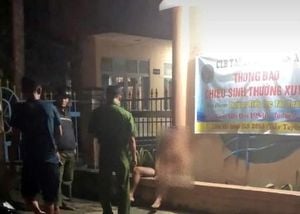Jon Imanol Sapieha Candela, known infamously as 'El Sapo', has stirred the waters of one of Madrid's most enduring mysteries by confessing to the burning of the Windsor building, which tragically engulfed the iconic structure on February 12, 2005. During his recent appearance on Cuatro, Sapieha boldly stated, "Ahora, os voy a confesar otra cosa: quemé el edificio Windsor." The confession has raised eyebrows and reopened discussions on the circumstances surrounding this catastrophic incident.
The Windsor building was known as one of the prominent skyscrapers in Madrid, but its reputation was forever altered when flames consumed it for over 24 hours. The official investigation concluded the fire began on the 21st floor, attributed to "a cigarette accidentally left burning". Yet, for nearly two decades, skeptics have questioned this explanation, speculating about possible darker motives behind the blaze.
El Sapo claims he was approached for the job and received instructions to destroy incriminatory documents believed to be harbored within the luxurious building. He described the setting of the clandestine meeting as quirkily inconspicuous: "Me citaron en El Álamo, un pueblo cerca de Madrid y nos reunimos a caballo. Dos personas que se encuentran a caballo no despiertan sospechas y no son escuchables." The secrecy shrouding their negotiations only amplifies the intrigue surrounding the incident.
According to the notorious thief, he demanded one million euros upfront for his services. "Me pagaron anticipado y en efectivo. Me entregaron una mochila con un millón de euros en billetes de 500," he revealed. Such amounts hinted at the high stakes involved, known only to those at the highest echelons of power.
Delving back to the morning of February 12, 2005, the Windsor building's flames reflected not just loss but also desperation. Firefighters battled the fierce blaze, which ravaged 15 floors. Despite the extensive damage, there were no reported casualties. After some days, authorities concluded they could demolish the building due to safety hazards related to its structural integrity.
The questions surrounding the event shifted again with El Sapo’s declarations. Critics and analysts are re-evaluing not only the cause but also the original intentions linked to the fire. While Sapieha does not express remorse for his alleged actions, he adamantly stated, "Soy un psicópata y con mucha honra." This chilling admission feeds speculation about his cold-blooded nature and whether he acted independently or was just another pawn in more prominent and protected interests.
Beyond presenting his version of events, El Sapo challenges the legitimacy of the official report and its conclusions about the fire's origins. He implied possible sabotage when he asserted, "El objetivo era que esos documentos no aparecieran y la forma sencilla era quemar el edificio." Such insinuations spark renewed discussions of powerful people wanting to bury the past, encapsulated within those missing documents.
The aftermath of the Windsor fire left deep scars on the financial district of Madrid, but Sapieha’s revelations strip it down to pure spectacle. The unintentional fallout from the fire, including economic costs, has cast long shadows on justice, leaving people wondering if one admission can illuminate those rangier shadows.
The former criminal elite’s confession has incentivized new investigations, prompting media outlets like DMAX to produce works about the Windsor fire and its enduring myths. The recently launched series, titled 'La maldición del Windsor', seeks to investigate the fire's legacy and whether it was circumstantial or orchestrated.
Will these new understandings impact how the public perceives the Windsor building or Sapieha himself? With the story now entangled with El Sapo's life narrative, spectators are left grappling with the duality of heroism and villainy entrenched within his story.
Still today, the Windsor fire remains etched not only in the memories of Madrid's residents but also within the annals of urban lore, compounded now with the tantalizing possibility of conspiracy and potentially sinister machinations surfacing from El Sapo's words.
Two decades later, with Sapieha's claims at the forefront, we are left contemplating; how much do we actually know about this dark chapter of Madrid’s history? The mystery hangs heavily over the city, with questions of culpability yet unanswered.



